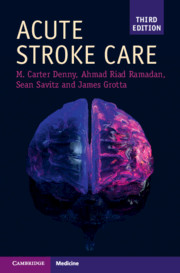Book contents
- Acute Stroke Care
- Acute Stroke Care
- Copyright page
- Contents
- Preface to the Third Edition
- Abbreviations
- Chapter 1 Stroke in the Emergency Department
- Chapter 2 What to Do First
- Chapter 3 Ischemic Stroke
- Chapter 4 Stroke Radiology
- Chapter 5 Intravenous Thrombolysis
- Chapter 6 Endovascular Therapy
- Chapter 7 Neurological Deterioration in Acute Ischemic Stroke
- Chapter 8 Ischemic Stroke Etiology and Secondary Prevention
- Chapter 9 Transient Ischemic Attack
- Chapter 10 Less Common Causes of Stroke
- Chapter 11 Cerebral Venous Sinus Thrombosis
- Chapter 12 Intracerebral Hemorrhage
- Chapter 13 Subarachnoid Hemorrhage
- Chapter 14 Organization of Stroke Care
- Chapter 15 Stroke Rehabilitation
- Chapter 16 Transition to Outpatient Stroke Care
- Book part
- Further In-Depth Reading
- Index
- Plate Section (PDF Only)
- References
Chapter 16 - Transition to Outpatient Stroke Care
Published online by Cambridge University Press: 28 October 2019
- Acute Stroke Care
- Acute Stroke Care
- Copyright page
- Contents
- Preface to the Third Edition
- Abbreviations
- Chapter 1 Stroke in the Emergency Department
- Chapter 2 What to Do First
- Chapter 3 Ischemic Stroke
- Chapter 4 Stroke Radiology
- Chapter 5 Intravenous Thrombolysis
- Chapter 6 Endovascular Therapy
- Chapter 7 Neurological Deterioration in Acute Ischemic Stroke
- Chapter 8 Ischemic Stroke Etiology and Secondary Prevention
- Chapter 9 Transient Ischemic Attack
- Chapter 10 Less Common Causes of Stroke
- Chapter 11 Cerebral Venous Sinus Thrombosis
- Chapter 12 Intracerebral Hemorrhage
- Chapter 13 Subarachnoid Hemorrhage
- Chapter 14 Organization of Stroke Care
- Chapter 15 Stroke Rehabilitation
- Chapter 16 Transition to Outpatient Stroke Care
- Book part
- Further In-Depth Reading
- Index
- Plate Section (PDF Only)
- References
Summary
It is never too early to begin to educate the patient and family about lifestyle changes and medical treatments to prevent another stroke. These need to be reinforced throughout the hospital and rehabilitation stay, and in the outpatient stroke clinic.
After a major stroke, both the family and the patient go through a grief reaction that at first includes denial and disbelief, and sometimes anger. In particular, the need to insert a PEG is often a crisis point when the family finally comes to terms with the severe disability and prolonged recovery that lies ahead. At this stage, which is usually when the patient is in the acute stroke unit, mainly supportive measures are indicated.
- Type
- Chapter
- Information
- Acute Stroke Care , pp. 237 - 240Publisher: Cambridge University PressPrint publication year: 2019

